Influence of Visual Coding Based on Attraction Effect on Human–Computer Interface
Abstract
1. Introduction
1.1. Analysis of Attraction Effect and Properties
1.2. Application of Attraction Effect in HCI and Eye Movement Technology
1.3. Analysis of Visual Element of Attraction Effect on HCI
2. Materials and Methods
2.1. Participants
2.2. Experiment Environment
- (1)
- Product images: To preserve the situational context of the image while reducing its interference with user decision-making, all alternatives use the same product image.
- (2)
- Product categories: To reduce the impact of product appearance on decision-making, this research selected practical products to ensure that the products are familiar to the majority of users. Finally, eight categories are determined, including cameras, headphones, electric toothbrushes, humidifiers, suitcases, projectors, robots, and bicycles.
- (3)
- Product properties: The selection of product properties combines the two methods of a questionnaire and pre-test. Regarding the questionnaire, the results are derived from the survey results of 37 valid questionnaires. They compare the weights of product properties involved in purchasing products and the selectable properties are derived from the product details of actual shopping websites. Each product in the questionnaire includes at least five properties for users to choose from. Regarding the pre-test, this research set up a binary set containing the Targets and the Competitors and a ternary set with the Decoys added. The questionnaire participants were asked to conduct the pre-test and were required to select the product they most wanted to buy based on the comprehensive judgment of the product’s properties. The negative properties value of the Competitor’s scheme is 10% weaker than the negative properties value of its dominant scheme, and the positive property value is the same as its dominant scheme. The properties values of the alternatives are adjusted according to the pre-test results to ensure that the experimental materials meet the preconditions for the attraction effect to be stimulated, as seen in Figure 1, especially if the properties of the Competitors are within the range threshold of the stimulated attraction effect. Information on the experiment products is shown in Table 1.
2.3. Experiment Apparatus
- (1)
- Tobii X2-30 is a compact device placed under a desktop computer interface that records participants’ eye movement data on the desktop computer interface. The non-contact sampling method and compensation algorithm are used to sample the position of participants’ eyeballs at a frequency of 30 Hz. Participants are free to move their heads in a free range without wearing any device, and the device does not interfere with participants’ visual activities. The experiment is programmed, stimuli presented, and eye movement data statistics performed using Tobii Studio 3.2.3.
- (2)
- The desktop computer interface, which is connected to eye movement, displays the experimental materials. The experimental materials used as stimuli are displayed on a 27-inch display screen (617.50 mm × 371.20 mm) with a resolution of 3840 × 2160 and a brightness of 92 cd/cm2.
2.4. Materials
2.5. Experimental Setting
2.6. Procedure
2.7. Data Analysis
3. Results
3.1. Behavioral Data
3.1.1. RST for Coding Modes and Attributes
3.1.2. Horizontal Analysis for Single Coding Mode and Attribute
3.1.3. Vertical Analysis for Comparing Different Coding Modes and Attributes
3.2. Eye Movement Data
3.2.1. Gaze Plot and Heat Map
3.2.2. Relative Fixation Time
- (1)
- Coding modesThe Friedman test for k-related samples was used to analyze the RFT under the coding attribute of similarity across different coding modes, revealing a significant difference (p = 0.015 < 0.05, = 10.421). A further pairwise comparison using the Wilcoxon signed-rank test showed significant differences between color coding and the no-coding mode (p = 0.003 < 0.05, Z , r ) and between color coding and label coding (p = 0.007 < 0.05, Z , r ). Marginal significance was found between color coding and size coding (p = 0.073 < 0.1, Z , r ) and between size coding and the no-coding mode (p = 0.091 < 0.1). No significant differences were observed in the other pairwise comparisons, as shown in Figure 13. Using the same analytical method, the RFT under the coding attribute of difference across different coding modes was compared, and the results indicated no significant differences between the coding modes (p = 0.974 > 0.05, = 0.221).
- (2)
- Coding attributesThe Wilcoxon signed-rank test was used to analyze the differences between coding attributes under a single coding mode. The results showed a significant difference in the RFT for the Target only under color coding (p = 0.002 < 0.05, Z , r ). Marginal significance was observed under size coding (p = 0.097 < 0.1, Z , r ), while no significant differences were found under label coding, as shown in Figure 14.
3.3. Subjective Questionnaire Data
3.3.1. Impact of Attention on Coding Modes
3.3.2. Preference Degree for Coding Modes
3.3.3. Preference Degree for Coding Alternatives
4. Discussion
4.1. Theoretical Implications
- (1)
- The impact of different coding modes on the attraction effect: Various coding modes can stimulate attraction effects, but there are differences in intensity. Under the coding attribute of similarity, color coding has the strongest attraction effect, and size coding has a slightly stronger attraction effect than the no-coding mode. There is no significant difference between label coding and size coding. Under the coding attribute of difference, the intensity of the attraction effect produced by each coding mode is roughly the same.
- (2)
- The impact of different coding attributes on the attraction effect: Various coding attributes can stimulate attraction effects, and the intensity depends on the coding mode. In the color and size coding modes, the attraction effect of the coding attribute of similarity is greater than that of difference. Under the label coding mode, there is no significant difference in the intensity of the attraction effect of similarity and difference.
4.2. Practical Implications
- (1)
- There are differences in the RFT of the Targets for different coding attributes. Specifically, the coding attribute of similarity is greater than that of difference under color coding; the coding attribute of similarity is slightly greater than that of difference under size coding; and there is no difference under label coding. The results of the eye movement data are consistent with the results of the behavioral data. There is no conflict between subjective questionnaires and objective indicators. This indicates that the change in attention caused by coding attributes can affect the intensity of the attraction effect.
- (2)
- There are differences in the RFT of the Targets under the similarity of different coding modes. Specifically, the RFT is the largest under color coding, slightly higher than that of the no-coding mode under size coding, and there is no difference between label coding and the no-coding modes. The results of the eye movement data are consistent with the results of the behavioral data, indicating that color coding has the best effect on attention changing, followed by size coding, and label coding has no obvious effect.
5. Conclusions
Author Contributions
Funding
Institutional Review Board Statement
Informed Consent Statement
Data Availability Statement
Acknowledgments
Conflicts of Interest
Abbreviations
| HCI | Human–computer interface |
| AI | Artificial intelligence |
| AR | Augmented reality |
| WITMED | Wise information technology of med |
| IM | Intelligent manufacturing |
| NPPs | Nuclear power plants |
| ECAM | Electronic centralized aircraft monitoring |
| ITS | Manned spacecraft and intelligent transport system |
| GP | Gaze plot |
| HM | Heat map |
| RFT | Relative fixation time |
References
- Tong, M.; Chen, S.; Tang, W.; Zhang, Y.; Xue, C. Selecting the appropriate speed for rotational elements in human-machine interfaces: A quantitative study. J. Eye Mov. Res. 2024, 17, 1. [Google Scholar] [CrossRef] [PubMed]
- Niu, Y.-F.; Gao, Y.; Zhang, Y.-T.; Xue, C.-Q.; Yang, L.-X. Improving eye–computer interaction interface design: Ergonomic investigations of the optimum target size and gaze-triggering dwell time. J. Eye Mov. Res. 2019, 12, 8. [Google Scholar] [CrossRef] [PubMed]
- Guath, M.; Stikvoort, B.; Juslin, P. Nudging for eco-friendly online shopping–Attraction effect curbs price sensitivity. J. Environ. Psychol. 2022, 81, 101821. [Google Scholar] [CrossRef]
- Orquin, J.L.; Loose, S.M. Attention and choice: A review on eye movements in decision making. Acta Psychol. 2013, 144, 190–206. [Google Scholar]
- Bhatia, S. Choice rules and accumulator networks. Decision 2017, 4, 146. [Google Scholar] [CrossRef]
- Noguchi, T.; Stewart, N. Multialternative decision by sampling: A model of decision making constrained by process data. Psychol. Rev. 2018, 125, 512. [Google Scholar] [CrossRef]
- Marini, M.; Ansani, A.; Paglieri, F. Attraction comes from many sources: Attentional and comparative processes in decoy effects. Judgm. Decis. Mak. 2020, 15, 704–726. [Google Scholar] [CrossRef]
- Huber, J.; Payne, J.W.; Puto, C. Adding asymmetrically dominated alternatives: Violations of regularity and the similarity hypothesis. J. Consum. Res. 1982, 9, 90–98. [Google Scholar] [CrossRef]
- Milberg, S.J.; Silva, M.; Celedon, P.; Sinn, F. Synthesis of attraction effect research: Practical market implications? Eur. J. Mark. 2014, 48, 1413–1430. [Google Scholar] [CrossRef]
- Wang, L.; Tang, W.; Montagu, E.; Wu, X.; Xue, C. Cognitive evaluation based on regression and eye-tracking for layout on human–computer multi-interface. Behav. Inf. Technol. 2024, 14, 1128. [Google Scholar] [CrossRef]
- Wiȩckowski, J.; Sałabun, W. Sensitivity analysis approaches in multi-criteria decision analysis: A systematic review. Appl. Soft Comput. 2023, 148, 110915. [Google Scholar]
- Grayot, J.D. Dual process theories in behavioral economics and neuroeconomics: A critical review. Rev. Philos. Psychol. 2020, 11, 105–136. [Google Scholar] [CrossRef]
- Kozyreva, A.; Lewandowsky, S.; Hertwig, R. Citizens versus the internet: Confronting digital challenges with cognitive tools. Psychol. Sci. Public Interest 2020, 21, 103–156. [Google Scholar] [PubMed]
- Gupta, S.; Modgil, S.; Bhattacharyya, S.; Bose, I. Artificial intelligence for decision support systems in the field of operations research: Review and future scope of research. Ann. Oper. Res. 2022, 308, 215–274. [Google Scholar]
- Zhao, Z.; Fan, W.; Li, J.; Liu, Y.; Mei, X.; Wang, Y.; Wen, Z.; Wang, F.; Zhao, X.; Tang, J. Recommender systems in the era of large language models (llms). arXiv 2023, arXiv:2307.02046. [Google Scholar] [CrossRef]
- Dumbalska, T.; Li, V.; Tsetsos, K.; Summerfield, C. A map of decoy influence in human multialternative choice. Proc. Natl. Acad. Sci. USA 2020, 117, 25169–25178. [Google Scholar]
- Frederick, S.; Lee, L.; Baskin, E. The limits of attraction. J. Mark. Res. 2014, 51, 487–507. [Google Scholar]
- Lichters, M.; Bengart, P.; Sarstedt, M.; Vogt, B. What really matters in attraction effect research: When choices have economic consequences. Mark. Lett. 2017, 28, 127–138. [Google Scholar]
- Padamwar, P.K.; Dawra, J.; Kalakbandi, V.K. The impact of range extension on the attraction effect. J. Bus. Res. 2021, 126, 565–577. [Google Scholar] [CrossRef]
- Kaptein, M.C.; Van Emden, R.; Iannuzzi, D. Tracking the decoy: Maximizing the decoy effect through sequential experimentation. Palgrave Commun. 2016, 2, 16082. [Google Scholar]
- Dimara, E.; Bezerianos, A.; Dragicevic, P. The attraction effect in information visualization. IEEE Trans. Vis. Comput. Graph. 2016, 23, 471–480. [Google Scholar] [CrossRef] [PubMed]
- Jeong, Y.; Oh, S.; Kang, Y.; Kim, S.-H. Impacts of visualizations on decoy effects. Int. J. Environ. Res. Public Health 2021, 18, 12674. [Google Scholar] [CrossRef] [PubMed]
- Rayner, K. Eye movements in reading and information processing: 20 years of research. Psychol. Bull. 1998, 124, 372–422. [Google Scholar] [CrossRef]
- Larsson, L.; Nyström, M.; Andersson, R.; Stridh, M. Detection of fixations and smooth pursuit movements in high-speed eye-tracking data. Biomed. Signal Process. Control 2015, 18, 145–152. [Google Scholar] [CrossRef]
- Montague, E.; Bungum, M.; Sherman, L.; Gravenor, S.; Courtney, D.M.; Czerniak, A.; Wolf, M.; McCarthy, D. Using a sociotechnical systems analysis to evaluate an intervention to improve opioid prescribing in emergency medicine. Appl. Ergon. 2021, 97, 103495. [Google Scholar] [CrossRef]
- Lu, Y.Q.; Adrados, J.S.; Chand, S.S.; Wang, L.H. Humans Are Not Machines-Anthropocentric Human-Machine Symbiosis for Ultra-Flexible Smart Manufacturing. Engineering 2021, 7, 734–737. [Google Scholar] [CrossRef]
- Tian, Y.T.; Zhao, Y.B.; Shi, Y.R.; Cao, X.H.; Yu, D.L. The Indirect Shared Steering Control Under Double Loop Structure of Driver and Automation. IEEE/CAA J. Autom. Sin. 2020, 7, 1403–1416. [Google Scholar] [CrossRef]
- Dombi, J.; Sydorenko, T.; Timpe-Laughlin, V. Common ground, cooperation, and recipient design in human-computer interactions. J. Pragmat. 2022, 193, 4–20. [Google Scholar] [CrossRef]
- Simon, H.A. A behavioral model of rational choice. Q. J. Econ. 1955, 69, 99–118. [Google Scholar] [CrossRef]
- Cho, I.; Wesslen, R.; Karduni, A.; Santhanam, S.; Shaikh, S.; Dou, W. The anchoring effect in decision-making with visual analytics. In Proceedings of the 2017 IEEE Conference on Visual Analytics Science and Technology (VAST), Phoenix, AZ, USA, 3–6 October 2017; pp. 116–126. [Google Scholar]
- Roe, R.M., Jr.; Busemeyer, J.R.; Townsend, J.T. Multialternative decision field theory: A dynamic connectionst model of decision making. Psychol. Rev. 2001, 108, 370. [Google Scholar] [CrossRef]
- Ok, E.A.; Ortoleva, P.; Riella, G. Revealed (p) reference theory. Am. Econ. Rev. 2015, 105, 299–321. [Google Scholar] [CrossRef]
- Bordalo, P.; Gennaioli, N.; Shleifer, A. Salience and consumer choice. J. Political Econ. 2013, 121, 803–843. [Google Scholar]
- Trueblood, J.S. Theories of context effects in multialternative, multiattribute choice. Curr. Dir. Psychol. Sci. 2022, 31, 428–435. [Google Scholar] [CrossRef]
- Bhatia, S. Confirmatory search and asymmetric dominance. J. Behav. Decis. Mak. 2014, 27, 468–476. [Google Scholar]
- Benedetto, S.; Pedrotti, M.; Bridgeman, B. Microsaccades and exploratory saccades in a naturalistic environment. J. Eye Mov. Res. 2011, 4, 2. [Google Scholar] [CrossRef]
- Zeng, Z.; Liu, S.; Cheng, H.; Liu, H.; Li, Y.; Feng, Y.; Siebert, F.W. GaVe: A webcam-based gaze vending interface using one-point calibration. J. Eye Mov. Res. 2023, 16, 2. [Google Scholar] [CrossRef]
- Zhang, Q.; Liu, Y. The Influence of Information Processing Mode and Information Presentation Pattern on Attraction Effect in Area Comparison Judgments. Acta Psychol. Sin. 2014, 46, 1639. [Google Scholar]
- Pettibone, J.C. Testing the effect of time pressure on asymmetric dominance and compromise decoys in choice. Judgm. Decis. Mak. 2012, 7, 513–521. [Google Scholar]
- Spektor, M.S.; Bhatia, S.; Gluth, S. The elusiveness of context effects in decision making. Trends Cogn. Sci. 2021, 25, 843–854. [Google Scholar]
- Orquin, J.L.; Perkovic, S.; Grunert, K.G. Visual biases in decision making. Appl. Econ. Perspect. Policy 2018, 40, 523–537. [Google Scholar]
- Bhatia, S. Associations and the accumulation of preference. Psychol. Rev. 2013, 120, 522. [Google Scholar] [CrossRef]
- Izakson, L.; Zeevi, Y.; Levy, D.J. Attraction to similar options: The Gestalt law of proximity is related to the attraction effect. PLoS ONE 2020, 15, e0240937. [Google Scholar] [CrossRef]
- Kahneman, D. Thinking, Fast and Slow; Macmillan: New York, NY, USA, 2011. [Google Scholar]

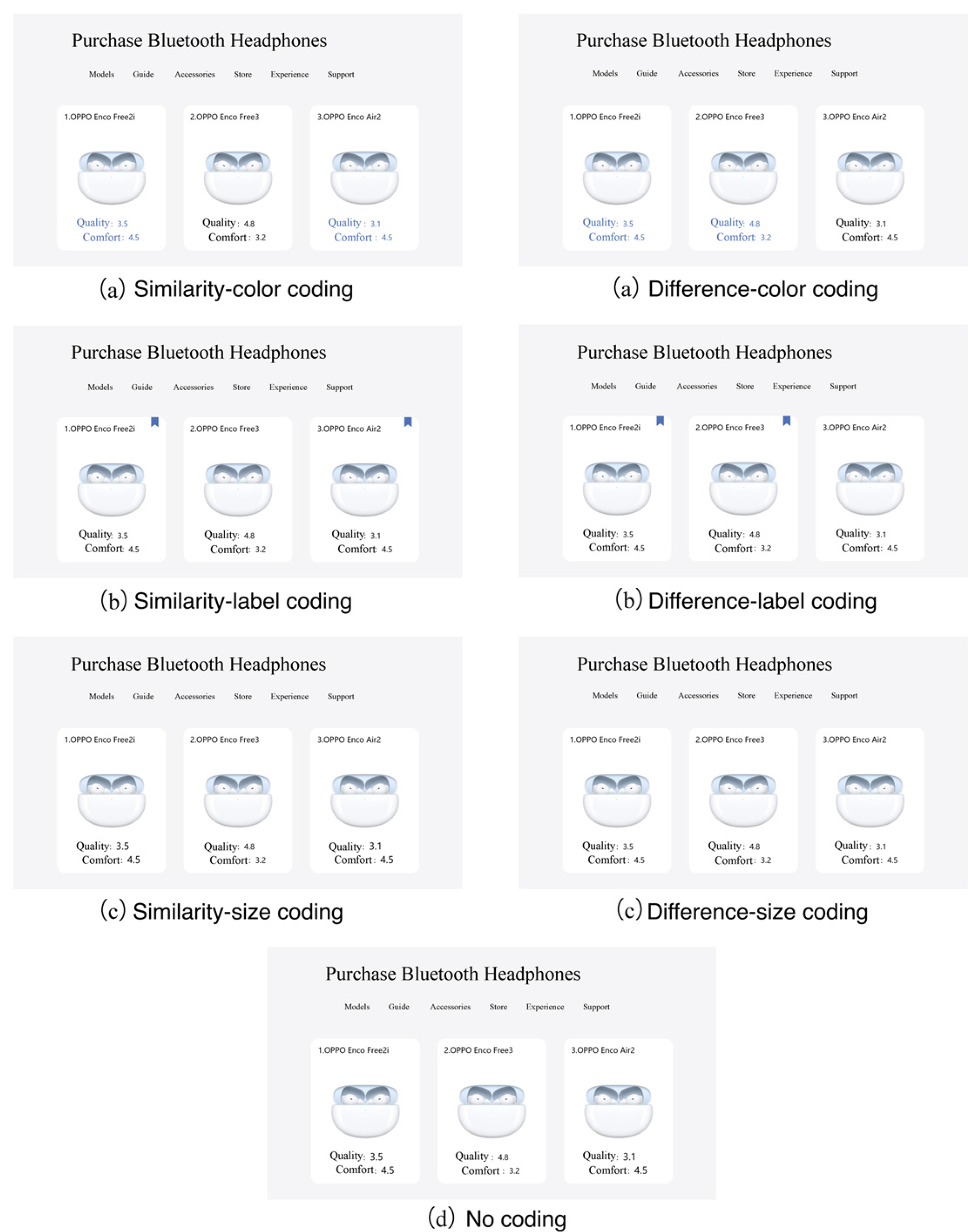
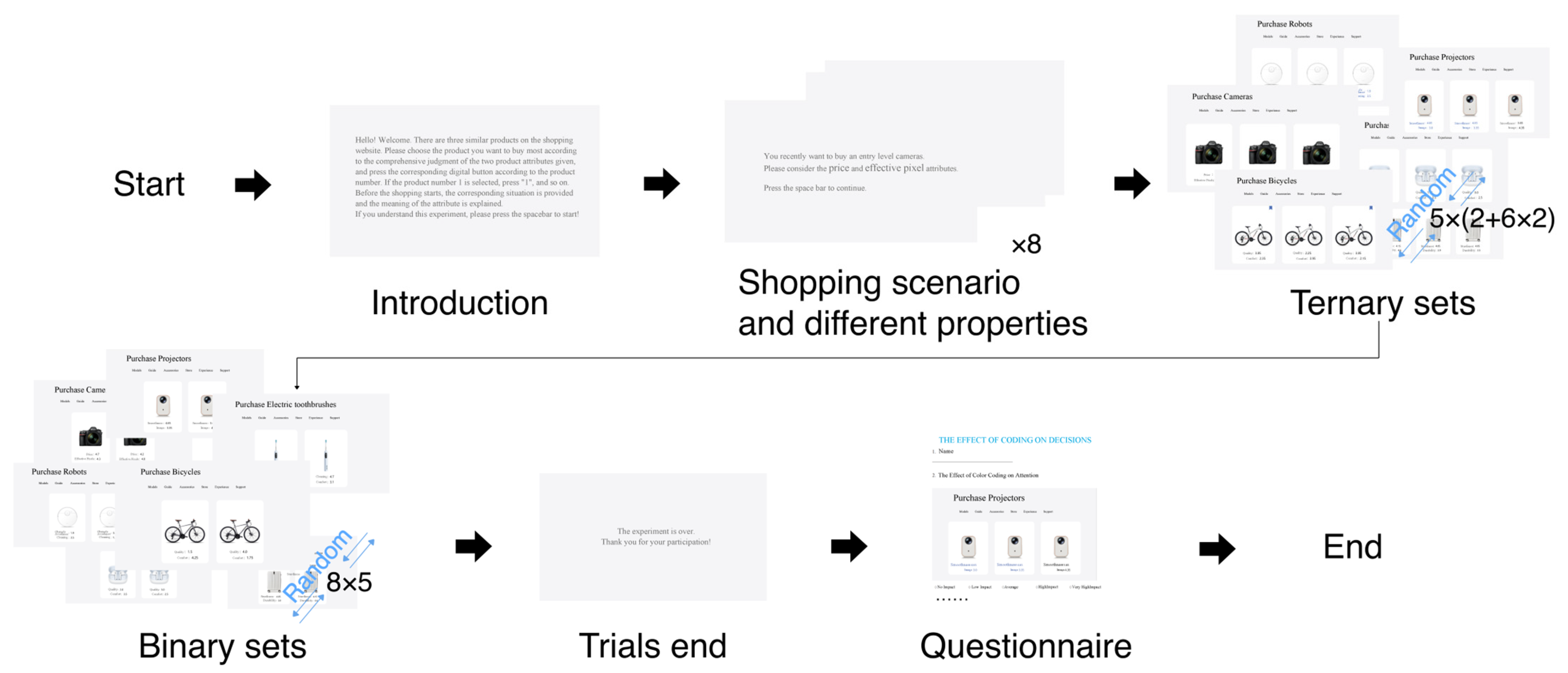


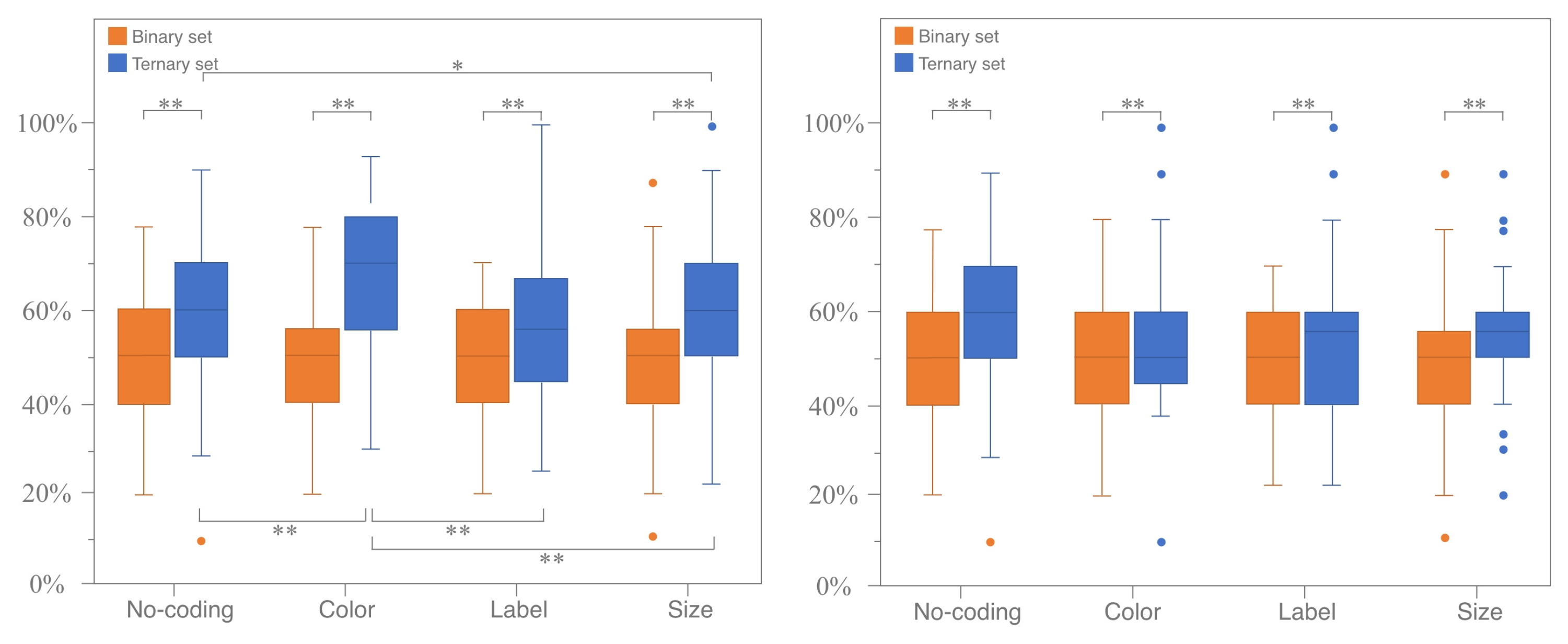


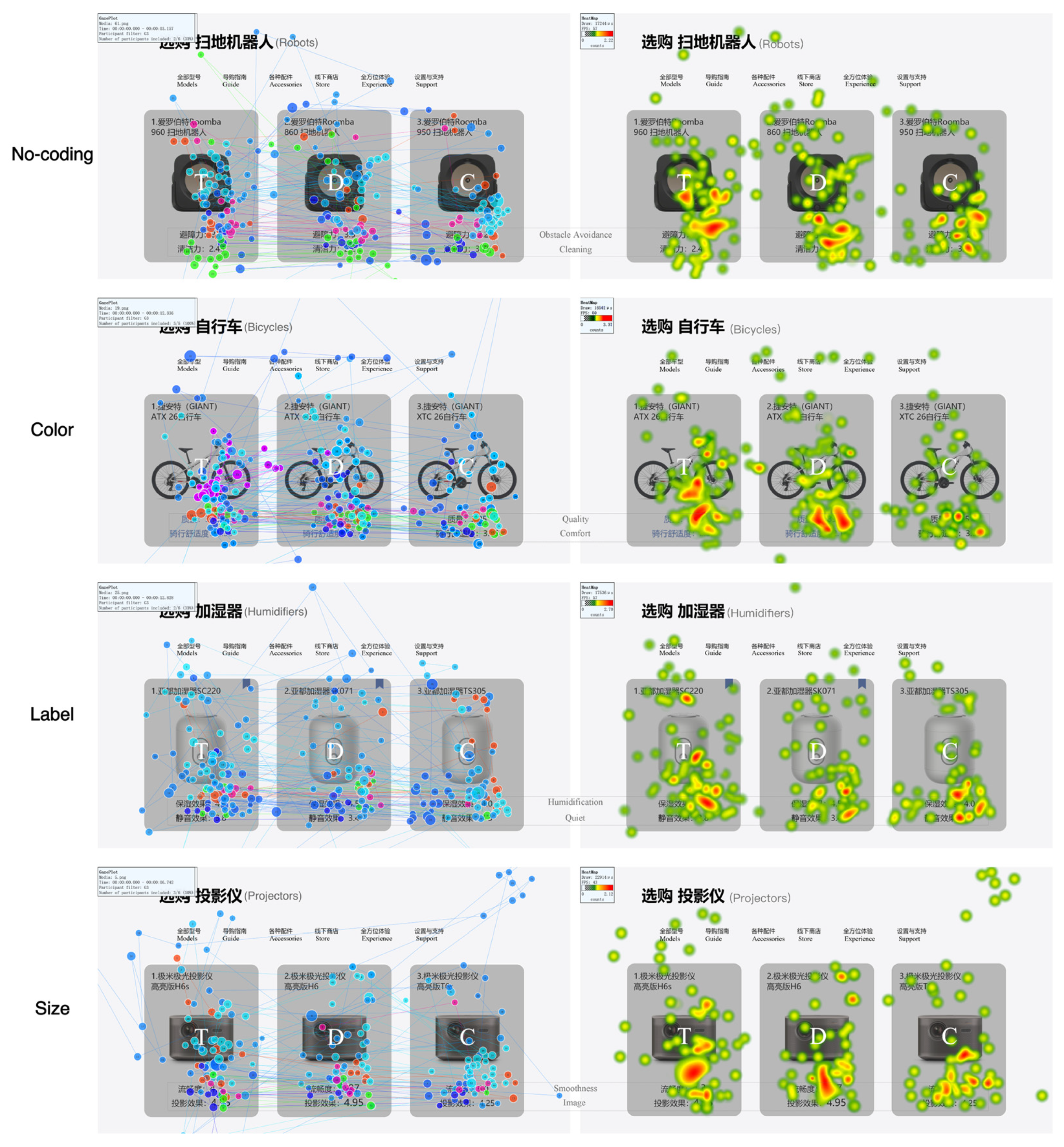
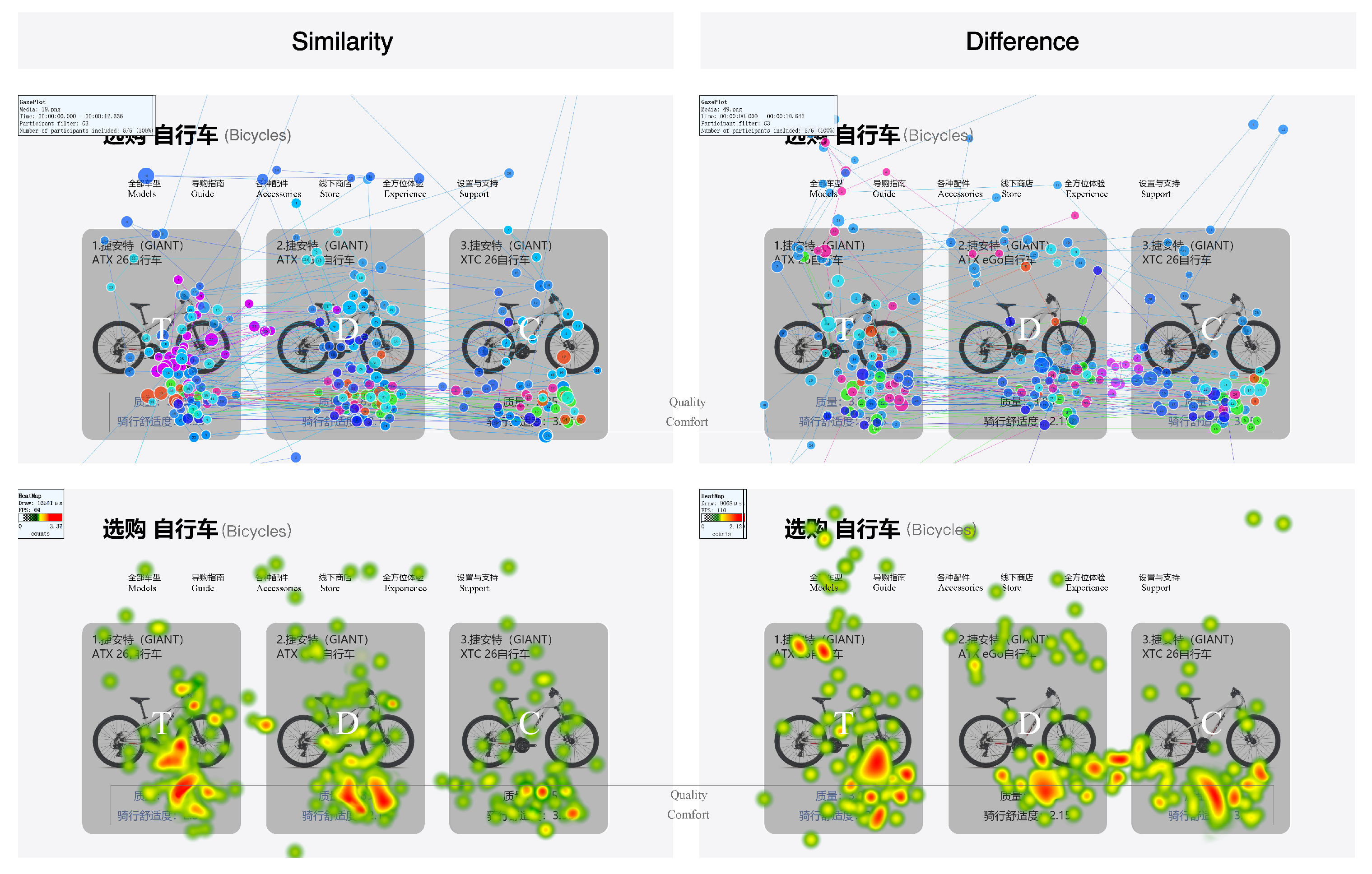
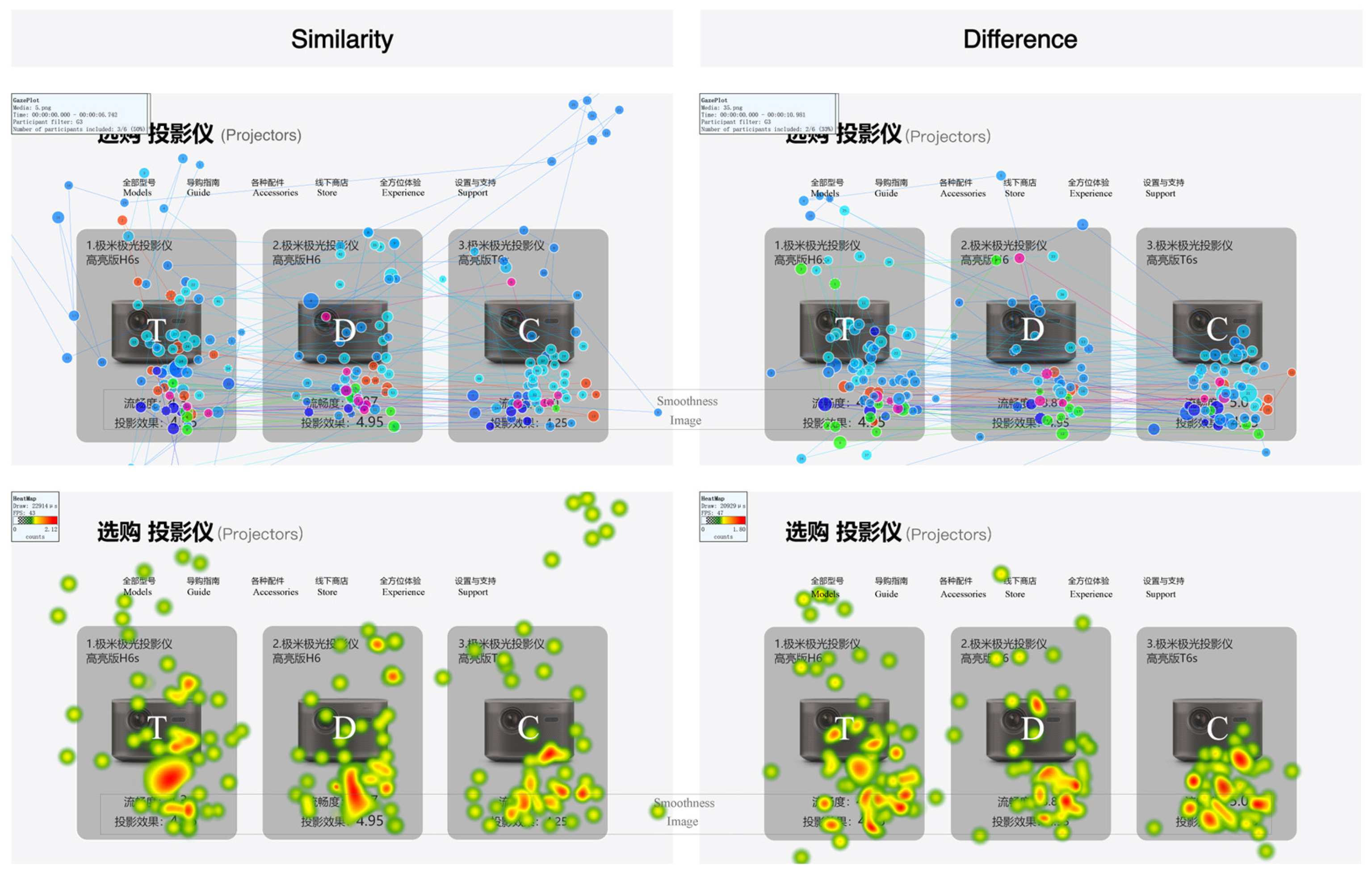
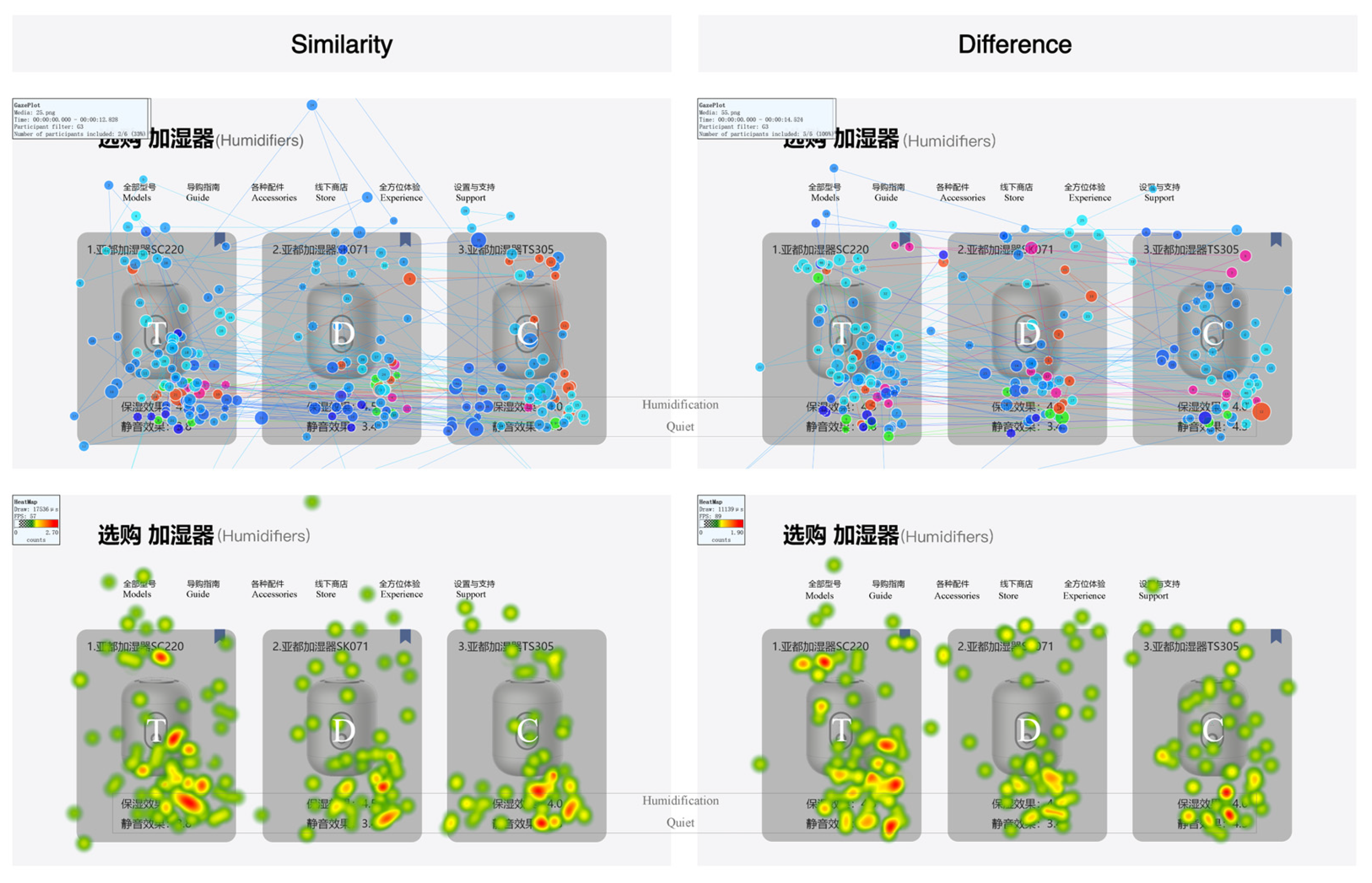
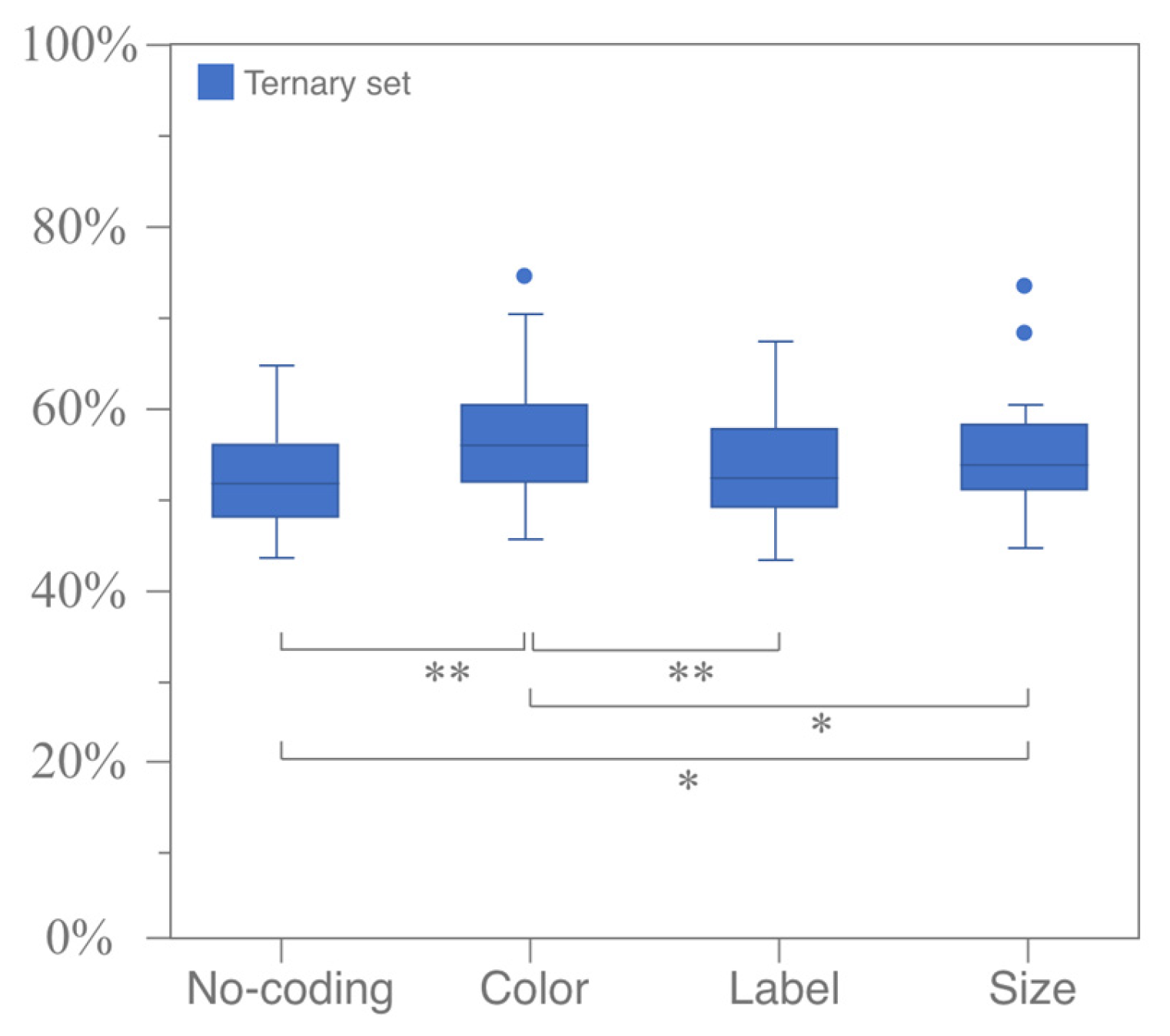
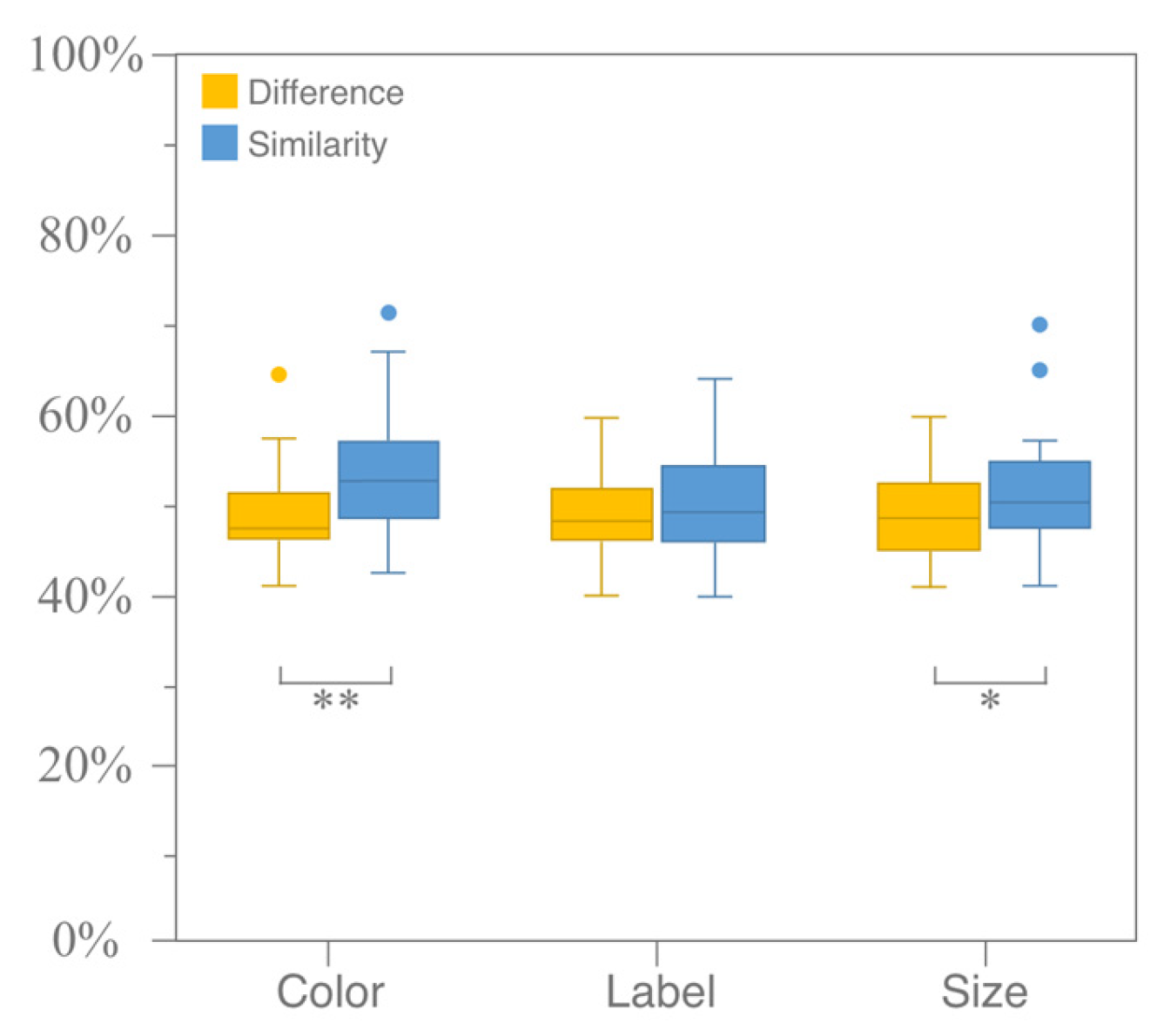

| Product Serial Number | Product Categories | Property 1 | Property 2 |
|---|---|---|---|
| 1 | Cameras | Price | Effective Pixels |
| 2 | Headphones | Quality | Comfort |
| 3 | Electric toothbrushes | Cleaning | Comfort |
| 4 | Humidifiers | Humidification | Quiet |
| 5 | Suitcases | Sturdiness | Durability |
| 6 | Projectors | Smoothness | Image |
| 7 | Robots | Obstacle Avoidance | Cleaning |
| 8 | Bicycles | Quality | Comfort |
| Question: How Much Do the Alternatives Coded by xx Affect Your Attention (Paying More Attention to These Alternatives During the Decision Process)? | ||||||
|---|---|---|---|---|---|---|
| Impact Level | No | Low | Moderate | High | Very High | |
| Coding Mode | ||||||
| Color coding | 16.92% (11) | 24.62% (16) | 18.46% (12) | 36.92% (24) | 3.08% (2) | |
| Label coding | 49.23% (32) | 23.08% (15) | 12.31% (8) | 12.31% (8) | 3.08% (2) | |
| Size coding | 13.85% (9) | 21.54% (14) | 33.85% (22) | 23.08% (15) | 7.69% (5) | |
| Question: Please Rank the Three Coding Modes Used to Highlight Information on the Shopping Interface According to Your Preference. | ||||
|---|---|---|---|---|
| Coding Mode | Average Composite Score | 1 | 2 | 3 |
| Color coding | 2.32 | 52.31% (34) | 31.15% (19) | 18.33% (11) |
| Label coding | 1.57 | 16.92% (11) | 31.15% (19) | 51.67% (31) |
| Size coding | 1.91 | 30.77% (20) | 37.70% (23) | 30.00% (18) |
Disclaimer/Publisher’s Note: The statements, opinions and data contained in all publications are solely those of the individual author(s) and contributor(s) and not of MDPI and/or the editor(s). MDPI and/or the editor(s) disclaim responsibility for any injury to people or property resulting from any ideas, methods, instructions or products referred to in the content. |
© 2025 by the authors. Licensee MDPI, Basel, Switzerland. This article is an open access article distributed under the terms and conditions of the Creative Commons Attribution (CC BY) license (https://creativecommons.org/licenses/by/4.0/).
Share and Cite
Wang, L.; Liu, Y.; Tang, X.; Xue, C.; Wang, H. Influence of Visual Coding Based on Attraction Effect on Human–Computer Interface. J. Eye Mov. Res. 2025, 18, 12. https://doi.org/10.3390/jemr18020012
Wang L, Liu Y, Tang X, Xue C, Wang H. Influence of Visual Coding Based on Attraction Effect on Human–Computer Interface. Journal of Eye Movement Research. 2025; 18(2):12. https://doi.org/10.3390/jemr18020012
Chicago/Turabian StyleWang, Linlin, Yujie Liu, Xinyi Tang, Chengqi Xue, and Haiyan Wang. 2025. "Influence of Visual Coding Based on Attraction Effect on Human–Computer Interface" Journal of Eye Movement Research 18, no. 2: 12. https://doi.org/10.3390/jemr18020012
APA StyleWang, L., Liu, Y., Tang, X., Xue, C., & Wang, H. (2025). Influence of Visual Coding Based on Attraction Effect on Human–Computer Interface. Journal of Eye Movement Research, 18(2), 12. https://doi.org/10.3390/jemr18020012





